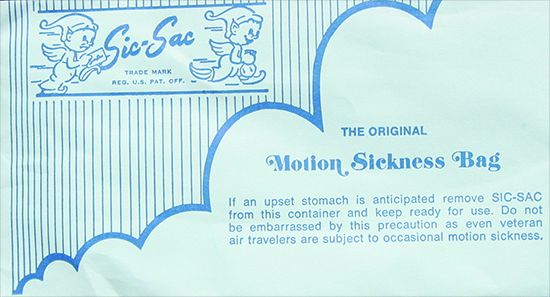It was a beautiful day for flying, if a bit breezy, which contributed some bumps. That would be important later. Meanwhile, I was out with a new-to-me rented Cessna 210 to bore some holes with a pilot-rated friend. After boring holes in the local airspace, we headed back to the airplane’s home base. The bumps continued.
I didn’t know it at the time, but my right-seater was getting a bit green around the gills. As he was an experienced pilot, certainly no stranger to an upset atmosphere; perhaps he’d had something unusual at his recent meal. Perhaps he thought his motion sickness would subside. It didn’t.
The airplane’s base was busy, befitting the good spring weather. As I maneuvered to enter the traffic pattern on the 45, my passenger said something like, “I’m going to be sick.” I turned away from the airport momentarily and fished around in my flight bag for one of the Sic-Sacs I carry for this purpose. It came in handy.
With my passenger apologizing and the bumps continuing, I pointed the airplane back at the destination airport and entered the pattern, moving the landing gear handle to the extended position abeam the runway numbers. The system whirred for a few moments, the gear started to extend and then the process stopped. The circuit breaker had popped. No green lights.
I radioed on the CTAF that we had a landing gear problem and would be departing the pattern, then pulled out the airplane’s checklist and started going through the procedures. With the circuit breaker reset, nothing happened. I put the switch in the gear-retracted position, and it folded neatly up into the airplane’s belly. Taking a deep breath, I moved it back to the extended position. It was déjà vu all over again: The gear partially extended and then stopped, with an open circuit breaker.
My right-seater was no help: he literally was holding the bag, still experiencing discomfort and unsure what was next. I was flying the airplane and running the checklist again, progressing from a circuit breaker reset to extending the emergency landing gear handle and starting to pump.
All the books and magazines strongly advise to divide your attention between flying the airplane and managing the emergency extension procedure. They’re right. As the gear slowly extended with each pump of the handle, the airplane slowed, requiring pitch and power adjustments to maintain altitude. The pumping itself wasn’t difficult, but it was unnatural, requiring me to bend over and take my eyes off the panel and the outside world. After 10 strokes, I’d stop and review things, and then pump some more. The process eventually rewarded us with three green lights and, with the Sic-Sac firmly in hand, we returned to the traffic pattern, landing uneventfully.
Hearing of our gear dilemma, someone in the FBO had called for a fire truck, but it wasn’t needed. As we secured the airplane, I wished my friend a better day and made a mental note to order more Sic-Sacs.
Have you encountered a situation or hazardous condition that yielded lessons on how to better manage the risks involved in flying? Do you have an experience to share with Aviation Safety’s readers about an occasion that taught you something significant about ways to conduct safer flight operations? If so, we want to hear about it.
We encourage you to submit a brief (500 words) write-up of your Learning Experience to Aviation Safety for possible publication. Each month, Aviation Safety publishes a collection of similar experiences sent to us by readers. Sharing with others the benefit of your experience and the lessons you learned can be an invaluable aid to other pilots.
You can send your account directly to the editor by e-mailing it to [email protected]. Put “Learning Experience Submission” in the subject line; add your name and daytime telephone number at the bottom of the e-mail.
Your report will be considered for publication in the Aviation Safety’s readers’ forum, “Learning Experiences,” and may be edited for style and length. Anonymity is guaranteed if you want it. No one but Aviation Safety’s editor is permitted access to the reports. Your name and telephone number are requested only so that the editor can contact you, if necessary.
While we can’t guarantee your submission will get published, we can guarantee that we’ll closely review and consider using it.
All Learning Experience submissions become the property of Aviation Safety and may be republished.




